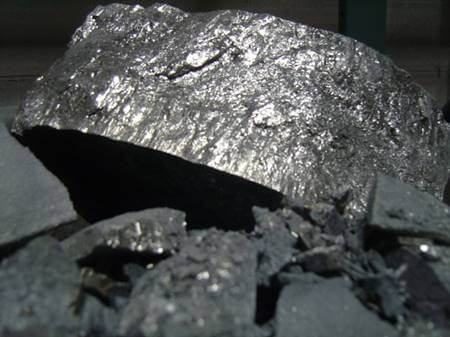Investors need
to expand their vocabulary with a new word
- niobium. Previously called columbium, it is a soft,
grey metal that looks suspiciously like a string of other metals on the
periodic table. It looks particularly
like a ‘soft, grey metal’ called tantalum, which is how it got its name. Niobe is the daughter of the character in
Greek mythology, Tantalus. Niobium was
recently featured in a report by a popular financial network and companies with
niobium interests are finding welcome at investment conferences.
Why has this little known element got the attention of
the financial press and investment bankers?
We look here at applications for niobium and the companies bringing it
to market.
Niobium is growing
in popularity for metal alloys. The
steel making industry uses it to brew up super-alloy steel that is superior in
strength without the extra weight that added steel would require for the same
performance. These super-alloys are
favorites for end products such pipe for gas transport or structural steel for
bridges and buildings.
The temperature stability
of the niobium also makes it attractive for use with nickel or cobalt alloys in
engines for rocket or jets. If titanium
and tin are mixed in with the niobium, the result is a corrosion-resistant
superconducting alloy that can be used in MRI scanners and other
electronics. Niobium could even end up
around your wrist or in jingling in your pocket. The metal has low toxicity and can be
colored, so it is used in jewelry and numismatics.
Niobium’s value
in creating high performance metal alloys has landed it on the list of
strategic metals that make up the National Defense Stockpile. It is perhaps the potential to reduce weight in transport
vehicles or defense equipment that is most attractive from a strategic
standpoint. Fuel efficiency could be
increased significantly with reduced weight in jets and spacecraft. That would save on fuel costs as well as
reduce environmental impact.
With the list of
potential uses building, it seems reasonable to expect demand for niobium to
grow. The steel industry is bar far the
largest buyer of niobium, usually in the form of ferro-niobium that has had
iron and aluminum add. Steel
applications represent about 80% of the market.
The total market value was about
$500 million in 2014.
Currently, niobium
sells for around $40 per kilogram, which is where it has traded since about
2008. It may seem odd that an input for
steel, which is typically discussed in terms of tons, is quoted in kilograms. However, niobium is used in precious small
quantities. The steel super-alloys
contain no more than 0.1% niobium. Higher
prices for niobium are probably in our future, but not until China intensifies
its usage of ferro-niobium for steel production. While steel producers in the U.S. are using
about 108 grams of ferro-niobium per ton of steel, China is uses only about 56
grams per ton. A change in China’s steel
production practices could have a dramatic impact on niobium demand and prices.
Brazil is the
largest producer of niobium, delivering about a third of supplies to the world
market. Canada is the second largest
source with 18%, following by Australia, 11% and Rwanda 8%. Recycling, which has been instrumental in
supplementing supplies of other metals, has been negligible for niobium. The United States imports as much as 95% of
its niobium requirements, which is an awkward situation given its berth on the
strategic stockpile list.
Niobium has
numerous uses and users, but few producers.
Indeed, there are only three companies generating niobium supplies in
quantity. CBMM and AngloAmerican Plc (AAL: London or NGLOY: OTC/PK) are two major
resource suppliers in Brazil. CBMM
produces about 110,000 tons of ferro-niobium per year and recently announced
plans to add capacity for another 150,000 tons by 2017. AngloAmerican is significantly smaller with
annual production near 10,000 tons per year.
The third major producer is Magris Resources’ Niobec subsidiary in
Canada, which also has 8,300 tons per year capacity.
This powerful troika
has not intimidated NioCorp
Developments Ltd. (NB: CVE or
NIOBF: OTC/PK). Formerly called Quantum Rare Earth
Developments, the company is working on the only known domestic niobium resource
located near Elk Creek, Nebraska. It is expected to yield scandium
and titanium as well as niobium. The Elk Creek resource is thought to be structurally similar to Niobec in Canada, but higher grade and larger. The company expects to produce 7,500 tons of ferro-niobium
annually as well as 23,000 tons of titanium dioxide and 12.8 tons of scandium
trioxide. A preliminary economic assessment completed
in 2015 suggested the resource has a potential 36-year life and present value
of $562 million net of $919 million in total capital costs and an allowance for contingencies.
Unlike the big
guys in Brazil and Canada, NioCorp has a struggle ahead to raise enough capital
for its Elk Creek plans. The company has
only $2.2 million in cash on its balance sheet at the end of December 2015,
which is probably needed to keep the lights on.
Over the past year, the company used $3.7 million in cash to support
development work on Elk Creek. The current
bank balance should keep the company afloat through July or August 2016.
Shareholders
just approved a warrant incentive program to encourage early exercise of
outstanding warrants that could yield about $7.1 million in new capital. The incentive program expires in mid-June. If successful, the warrant exercise could
provide a solid endorsement of NioCorp’s strategic plans as current
shareholders might be considered more knowledgeable than most in its merits.
Neither the author of the Small Cap Strategist web
log, Crystal Equity Research nor its affiliates have a beneficial interest in
the companies mentioned herein.

No comments:
Post a Comment